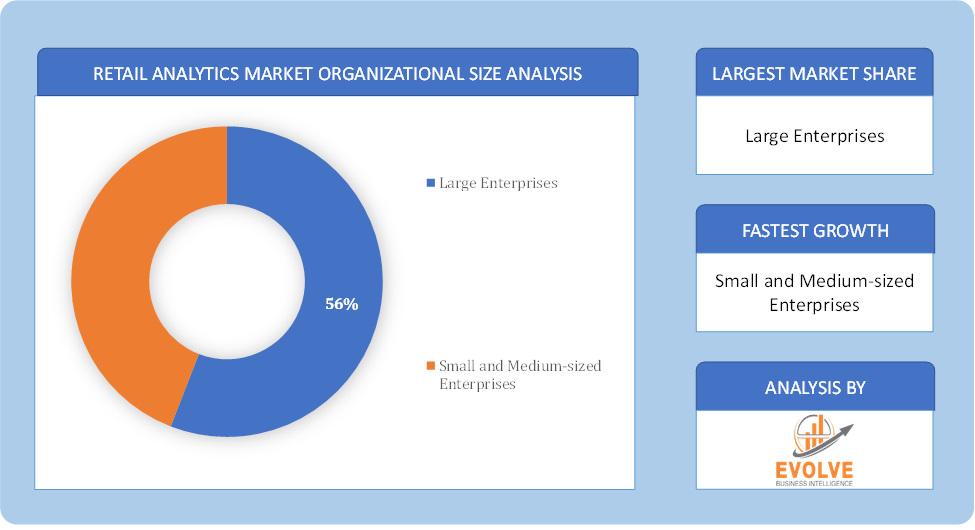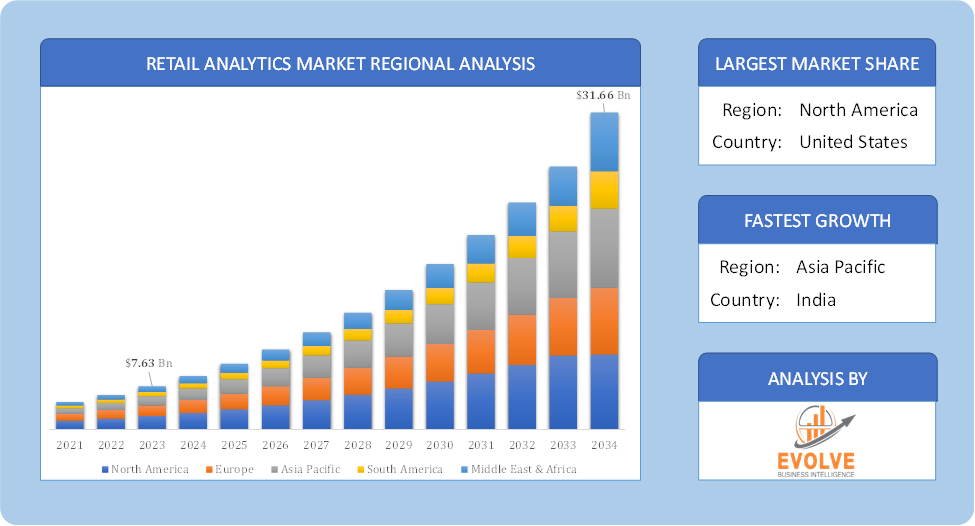Retail Analytics Market Analysis and Global Forecast 2024-2034
$1,390.00 – $5,520.00Price range: $1,390.00 through $5,520.00
Retail Analytics Market Research Report: Information By organization size (Large Enterprises, Small and Medium-sized Enterprises), By Application (Merchandising analysis, Pricing analysis, Customer analytics, Others), By business function (Finance, Marketing & Sales, Human Resources, Others), and by Region — Forecast till 2034
Page: 171
[vc_row][vc_column width=”2/3″][vc_column_text css=”” text_larger=”no” woodmart_inline=”no”]
Retail Analytics Market Overview
The Retail Analytics Market size accounted for USD 7.63 Billion in 2023 and is estimated to account for 8.75 Billion in 2024. The Market is expected to reach USD 31.66 Billion by 2034 growing at a compound annual growth rate (CAGR) of 4.23% from 2024 to 2034. The Retail Analytics Market refers to the collection and analysis of data related to retail operations in order to optimize decision-making, improve customer experience, enhance sales performance, and streamline operations. Retail analytics leverages data from various sources such as customer transactions, inventory management, supply chain operations, and in-store behaviour. The goal is to provide actionable insights into consumer behavior, sales trends, product performance, and marketing effectiveness.
The retail analytics market is driven by the increasing availability of data, advancements in technology, and the growing need for retailers to make data-driven decisions to remain competitive in today’s market.
Global Retail Analytics Market Synopsis
 Retail Analytics Market Dynamics
Retail Analytics Market Dynamics
The major factors that have impacted the growth of Retail Analytics Market are as follows:
Drivers:
Ø Need for Real-time Data Insights
Retailers seek real-time insights into consumer behavior, sales trends, and inventory levels to make quick, data-driven decisions. Retail analytics platforms provide this capability, enabling more agile business operations. Retail analytics helps optimize inventory levels, reduce stockouts, and manage supply chain disruptions by providing insights into demand patterns and supplier performance. The growing availability of scalable, cloud-based analytics solutions has made it easier for retailers of all sizes to adopt sophisticated analytics tools, reducing the barriers to entry.
Restraint:
- Perception of High Implementation Costs and
Deploying advanced retail analytics solutions can be expensive, particularly for small and medium-sized businesses (SMBs). The costs associated with software, infrastructure, data integration, and skilled personnel can hinder adoption. The shortage of data scientists, analysts, and IT professionals with expertise in retail analytics and big data tools can limit the market’s growth. Retailers may find it challenging to hire or train personnel to fully utilize advanced analytics platforms.
Opportunity:
⮚ Expansion of E-commerce and Omnichannel Retailing
With the continued rise of e-commerce and the blending of online and offline shopping experiences, retailers can use analytics to optimize omnichannel strategies, track customer journeys across platforms, and enhance personalized shopping experiences. With the proliferation of Internet of Things (IoT) devices such as smart shelves, cameras, and sensors in stores, retailers can collect vast amounts of in-store data. This creates an opportunity for real-time inventory management, customer tracking, and in-store optimization through analytics.
Retail Analytics Market Segment Overview
Based on Organization Size, the market is segmented based on Large Enterprises and Small and Medium-sized Enterprises. Large enterprises segment dominant the market owing to their rising emphasis on enhancing the interaction of consumers through the utilization of retail analytics. Large market players can invest in innovative technology, like retail analytics, due to their strong financial standing.
By Application
Based on Application, the market segment has been divided into Merchandising analysis, Pricing analysis, Customer analytics and Others. The Customer analytics segment dominant the market. Retail analytics can measure customer loyalty, identify purchasing patterns, forecast demand and optimize store layouts. This enhanced customer experience and help business to understand customer behavior.
By Business Function
Based on Business Function, the market segment has been divided into Finance, Marketing & Sales, Human Resources and Others. The Marketing & Sales segment dominant the market.
Global Retail Analytics Market Regional Analysis
Based on region, the global Retail Analytics Market has been divided into North America, Europe, Asia-Pacific, the Middle East & Africa, and Latin America. North America is projected to dominate the use of the Retail Analytics Market followed by the Asia-Pacific and Europe regions.
 Retail Analytics North America Market
Retail Analytics North America Market
North America holds a dominant position in the Retail Analytics Market. The high levels of digitalization, advanced e-commerce platforms, and widespread use of data-driven marketing strategies are driving market growth. The presence of major retail analytics solution providers and tech companies, particularly in the U.S., is also a significant contributor and the U.S. and Canada have mature retail markets, with a focus on omnichannel strategies, personalized customer experiences, and AI-based analytics. Retailers are also adopting cloud-based analytics solutions to streamline operations and enhance supply chain management.
Retail Analytics Asia-Pacific Market
The Asia-Pacific region has indeed emerged as the fastest-growing market for the Retail Analytics Market industry. The APAC region is seeing rapid growth due to the expansion of e-commerce, especially in countries like China, India, Japan, and Southeast Asia. Retailers in this region are investing in analytics to optimize online and offline retail operations and emerging markets like India and Southeast Asia present massive growth opportunities due to increasing smartphone penetration, digital payment systems, and growing internet usage. Cloud-based retail analytics and AI-driven solutions are seeing strong demand.
Competitive Landscape
The global Retail Analytics Market is highly competitive, with numerous players offering a wide range of software solutions. The competitive landscape is characterized by the presence of established companies, as well as emerging startups and niche players. To increase their market position and attract a wide consumer base, the businesses are employing various strategies, such as product launches, and strategic alliances.
Prominent Players:
- Microsoft
- IBM
- Oracle
- SAP
- SAS institute
- AWS
- Qlik
- Domo
- Vend
Key Development
In Feb 2024: Kroger partnered with Intelligence Node to enhance marketplace listings and provide clearer product guides for third-party vendors.
In Jan 2024, Microsoft announced the launch of new GenAI tools specifically designed for the retail industry, aiming to personalize shopping experiences and assist frontline workers in real time.
Scope of the Report
Global Retail Analytics Market, by Organization Size
- Large Enterprises
- Small and Medium-sized Enterprises
Global Retail Analytics Market, by Application
- Merchandising analysis
- Pricing analysis
- Customer analytics
- Others
Global Retail Analytics Market, by Business Function
- Finance
- Marketing & Sales
- Human Resources
- Others
Global Retail Analytics Market, by Region
- North America
- US
- Canada
- Mexico
- Europe
- UK
- Germany
- France
- Italy
- Spain
- Benelux
- Nordic
- Rest of Europe
- Asia Pacific
- China
- Japan
- South Korea
- Indonesia
- Austalia
- Malaysia
- India
- Rest of Asia Pacific
- South America
- Brazil
- Argentina
- Rest of South America
- Middle East & Africa
- Saudi Arabia
- UAE
- Egypt
- South Africa
- Rest of Middle East & Africa
| Parameters | Indicators |
|---|---|
| Market Size | 2034: USD 31.66 Billion |
| CAGR (2024-2034) | 4.23% |
| Base year | 2022 |
| Forecast Period | 2024-2034 |
| Historical Data | 2021 (2017 to 2020 On Demand) |
| Report Coverage | Revenue Forecast, Competitive Landscape, Growth Factors, and Trends |
| Key Segmentations | Organization Size, Application, Business Function |
| Geographies Covered | North America, Europe, Asia-Pacific, South America, Middle East, Africa |
| Key Vendors | Microsoft, IBM, Oracle, SAP, SAS institute, AWS, Qlik, Google, Domo and Vend. |
| Key Market Opportunities | · Expansion of E-commerce and Omnichannel Retailing
· Rise of Smart Stores and IoT Integration |
| Key Market Drivers | · Need for Real-time Data Insights
· Rising Adoption of Cloud-based Solutions |
REPORT CONTENT BRIEF:
- High-level analysis of the current and future Retail Analytics Market trends and opportunities
- Detailed analysis of current market drivers, restraining factors, and opportunities in the future
- Retail Analytics Market historical market size for the year 2021, and forecast from 2023 to 2033
- Retail Analytics Market share analysis at each product level
- Competitor analysis with detailed insight into its product segment, Government & Defense strength, and strategies adopted.
- Identifies key strategies adopted including product launches and developments, mergers and acquisitions, joint ventures, collaborations, and partnerships as well as funding taken and investment done, among others.
- To identify and understand the various factors involved in the global Retail Analytics Market affected by the pandemic
- To provide a detailed insight into the major companies operating in the market. The profiling will include the Government & Defense health of the company’s past 2-3 years with segmental and regional revenue breakup, product offering, recent developments, SWOT analysis, and key strategies.
[/vc_column_text][vc_column_text css=”” woodmart_inline=”no” text_larger=”no”]
Frequently Asked Questions (FAQ)
[sp_easyaccordion id=”75211″][/vc_column_text][/vc_column][vc_column width=”1/3″][vc_column_text text_larger=”no” woodmart_inline=”no”]
[html_block id=”3961″][/vc_column_text][vc_wp_text]
Press Release
[rpwe limit=”10″ thumb=”true”][/vc_wp_text][/vc_column][/vc_row]





